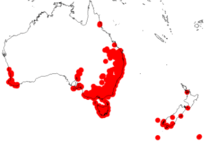Carex appressa
Carex appressa, commonly known as the tall sedge, is a species of flowering plant in the family Cyperaceae, commonly known as sedges.[1]
| Carex appressa | |
|---|---|
.jpg) | |
 | |
| Scientific classification | |
| Kingdom: | |
| (unranked): | |
| (unranked): | |
| (unranked): | |
| Order: | |
| Family: | |
| Genus: | |
| Species: | C. appressa |
| Binomial name | |
| Carex appressa R.Br. | |
 | |
| Australasian occurrence data from AVH | |
| Wikispecies has information related to Carex appressa |
| Wikimedia Commons has media related to Carex appressa. |
.jpg)
Description
Carex appressa is a densely tufted, perennial sedge that forms clumps up to 50 cm (20 in) in diameter. Its stems grow to around 100 cm (39 in) in height, and are hard and solid, becoming rough towards the top of the stem. Its leaves are 3–6 mm (0.12–0.24 in) wide, are rough on the margins, and grow mostly out of the base of the plant. It has a brownish, spike-like inflorescence made of 20 or more spikes, growing 5–25 cm (2.0–9.8 in) long. Its flowers are numerous oval-shaped brownish spikelets that are approximately 5 mm (0.20 in) long, with both male and female flowers mixed together in the spikes. Its nut is contained in a flattened, oval-shaped, beaked, hairless sack or utricle that is 3–3.5 mm (0.12–0.14 in) long.[2][3]
Habitat and Ecology
Carex appressa occurs in swamps, watercourses, and occasionally in water.[2] It is native to Malaysia, Australia, New Zealand, and generally in the South West Pacific.[4] It also serves as a larval food plant for Heteronympha cordace.[5]
References
- K. L. Wilson (2011). "Carex appressa". PlantNET – FloraOnline. New South Wales Flora Online. Retrieved 11 May 2016.
- GM Cunningham, Geoffrey McIver Cunningham (2011). Plants of Western New South Wales (illustrated ed.). Csiro Publishing. p. 155. ISBN 9780643103634.
- Judith Roderick Wheeler, N. G. Marchant, Margaret Lewington (2002). Flora of the South West: Bunbury, Augusta, Denmark. UWA Publishing. p. 267. ISBN 9780642568144.CS1 maint: multiple names: authors list (link)
- John H. Wiersema, Blanca León (2016). World Economic Plants: A Standard Reference (illustrated ed.). CRC Press. p. 143. ISBN 9781466576810.
- Ross Field (2013). Butterflies: Identification and life history (revised ed.). Museum Victoria. p. 188. ISBN 9781921833328.